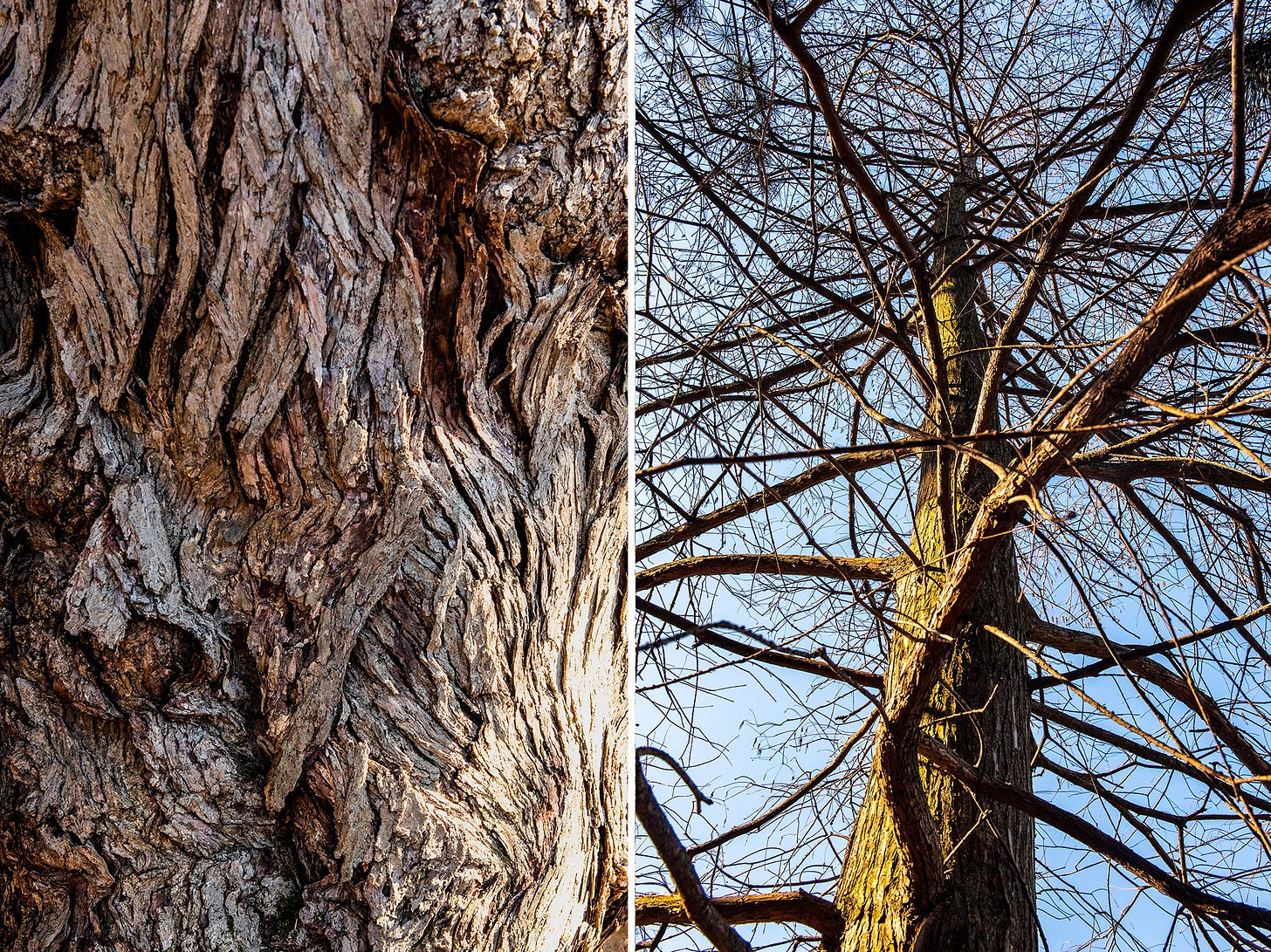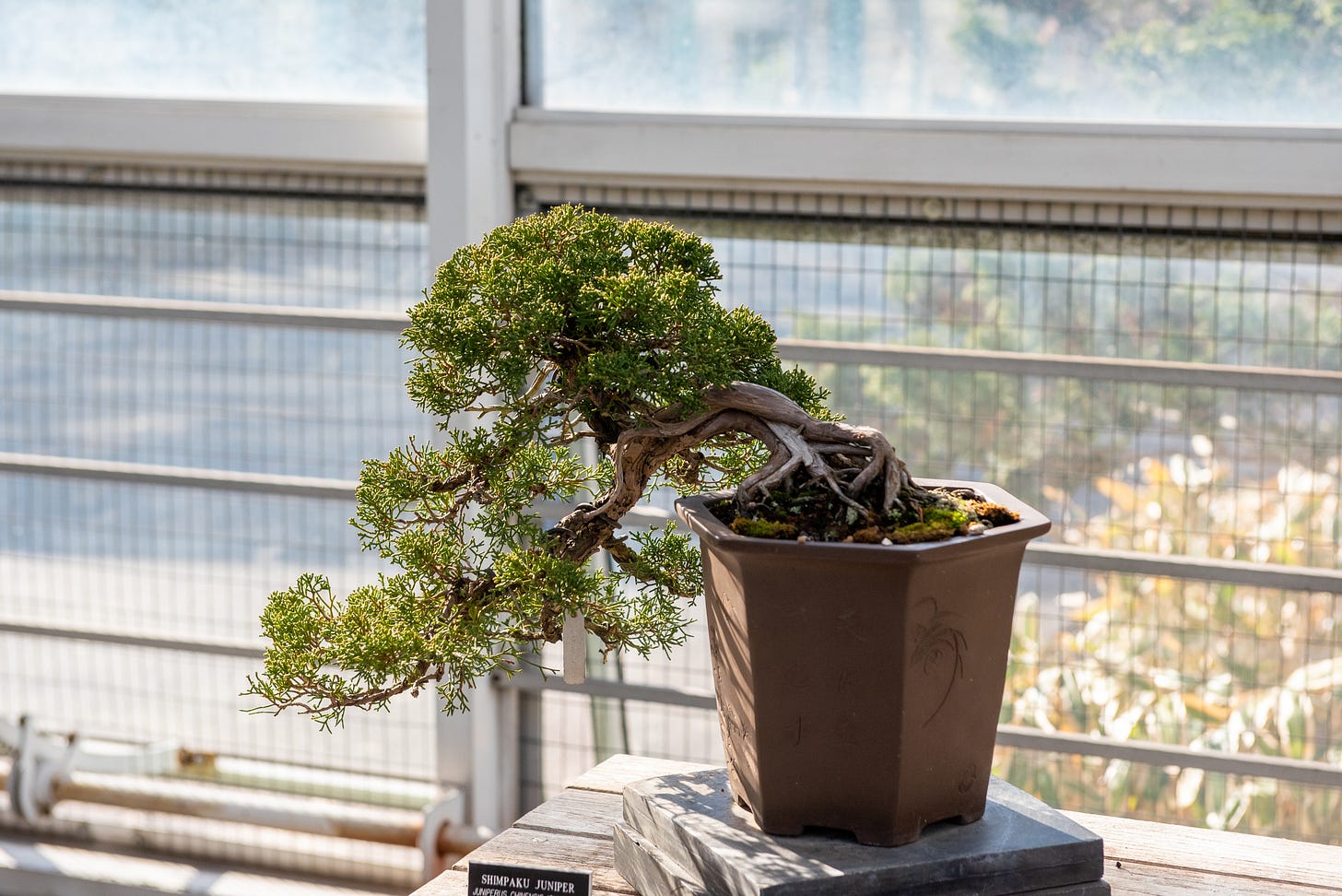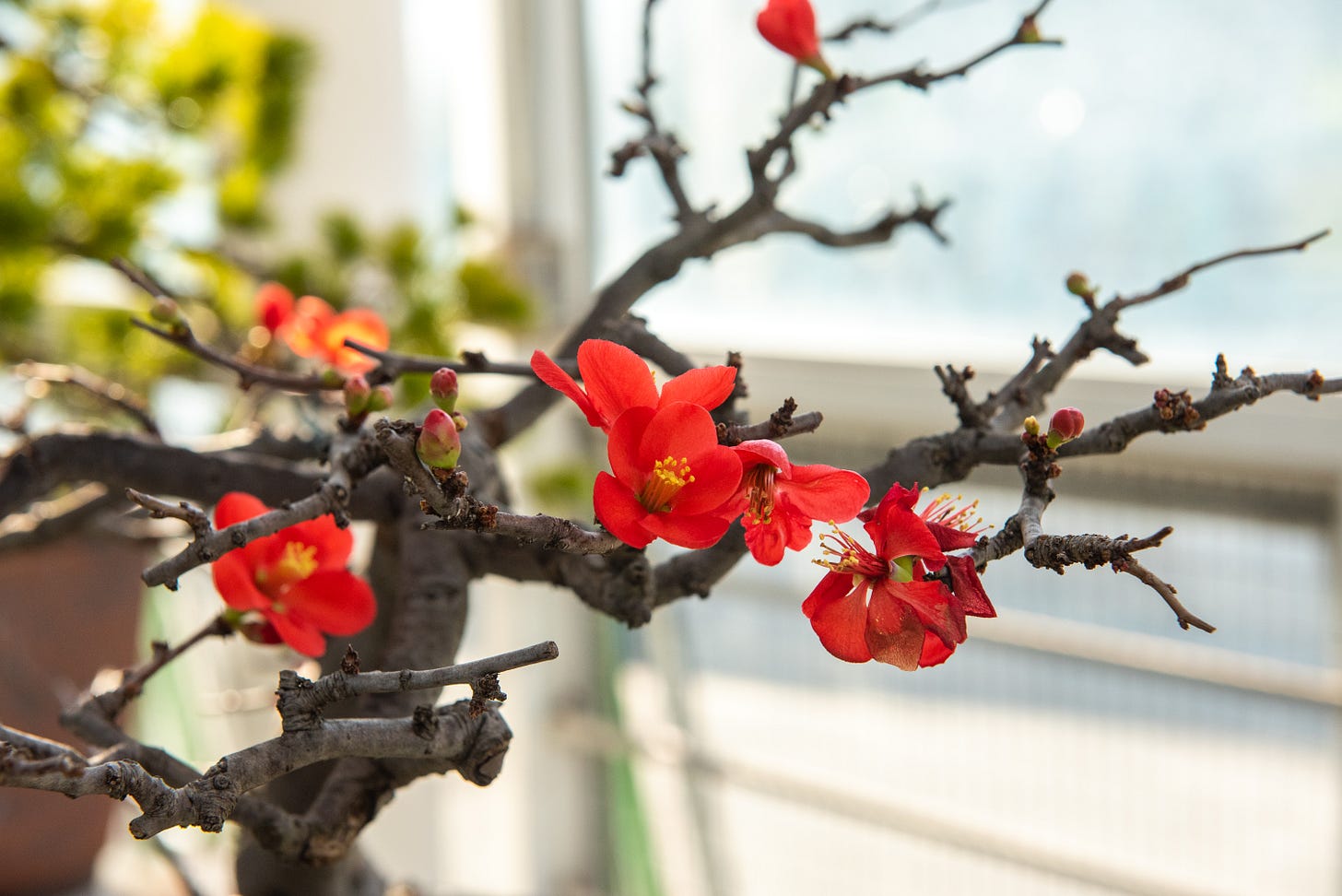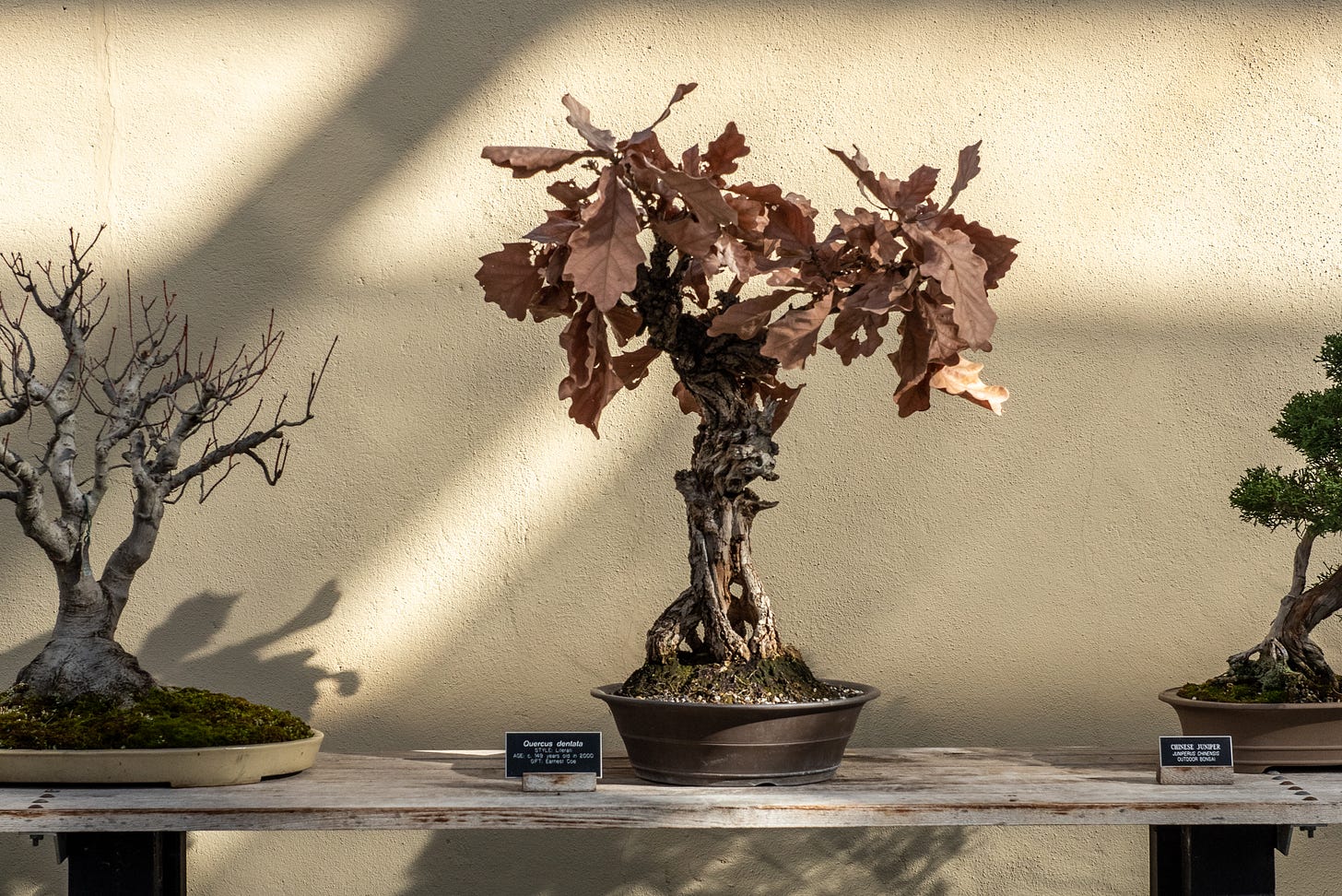Bare truths
A winter walk through the Brooklyn Botanic Garden and bonsai exhibit.
Winter is a delicious time to visit your local botanical garden. For one, nobody’s there; my friend Ethan and I practically had the place to ourselves. Compare this to my last visit in cherry blossom season, when I had to jump around tree roots to avoid getting caught in kawaii photo shoots.
Cold shoos the humans away and reduces the perennial plants to their barest forms. There are no blooms and little foliage. Only when we’re unburdened by those distractions do we get to see a tree’s true design on display.
Newly free of covid—thank you all for the kind words—I was itching to get out. I decided it was time to see the bonsai exhibit at the Brooklyn Botanic Garden.
But first, a walk through the grounds to gawk at bark and naked branches. During spring it’d be easy to overlook the freaky protrusions popping up around the bald cypress in the photo above. Now they’re clear and crisp as the winter sky. They’re “cypress knees”: root growths unique to swamp cypresses that live in water-saturated soil. Nobody’s sure what they do for the tree. I can only imagine the wood-working possibilities.
Bark is such an important part of a tree’s character. The fissured hickory bark above reminds me of a big shaggy dog. The redwood’s bark to the right is more flaky, like dry snake skin. I didn’t catch what species these other two trees are, but look at that ramification! There’s a fractal quality to the display, a dizzying instance of an abstract mathematical principle put into living practice.
One of the core pieces of advice I’ve gotten in bonsai is to study all the trees you can. Notice how they distribute their weight. The habits of their trunks.
I’m starting with this photo of a pitch pine bonsai and hornbeam forest to compare them to the full sized trees above. Look at how these diminutive bonsai capture the mature bark and contorted branching of trees in the wild! Knowing what little I do of what’s required to achieve this natural character, I’m in awe. Stepping back into my beginner’s mind, the awe continues. I’m glad that’s true—that even as I dig into the weeds of this hobby, I can still look up and drop my jaw in amazement.
This was my first experience up close with world class bonsai, and I’ll be honest with you, it was a moment. Photos of bonsai deceive you with scale. In person, the tree strains your vision, as if staring at an optical illusion. You struggle to accommodate two incompatible truths: the physical size of the tree in the pot and the impossible recognition of the giants it represents.
It’s a good reminder that much of the art in bonsai is really artifice. This juniper above is in a classic cascade form, resembling a tree growing on a rocky cliff. But what is this specific tree cascading from? At some point the artist likely tipped the pot on its side so the downward branches of the tree reached for the sky. Growers will do this for months or years to train a tree into this shape.
The moss on the tree beneath was probably added to the pot just for this display. Moss messes with soil drainage and prefers a wetter soil than most trees do. If you keep moss on your tree long term you risk choking the roots and rotting the surface bark. So instead an artist will keep a bonsai’s surface bare until it’s time for display, then layer fresh moss in tiny patches. The artist adds texture by flicking bonsai soil over the moss to replicate bare dirt holes in fields of grass. The moss may be held in place with wire.
The Botanic Garden has 400 bonsai that they rotate on display through the seasons. It is, they say, one of the largest bonsai collections outside of Japan, and who am I to say otherwise.
This quince must have just started flowering. Masks quashed any opportunity to give the flowers a whiff, but I think the quince used for bonsai are mostly about the visuals. Look at the bark, how the smooth stretches between nodes form squashy rolls at the junctions. A funny contrast to the beautiful flowers, which look to me like flamenco dancers kicking their legs.
This oak is my favorite of the current display. It’s estimated to be 150 years old. The placard says it’s styled with a literati design, but I don’t agree. Literati is an abstract style meant to convey the beauty of a tree just barely clinging to life, with minimal foliage and tortured contortions that no sane tree would undertake unless circumstances demanded. Literati trunks are long and thin without taper and lower branches.
To me, this tree looks too robust to convey that aesthetic of “beautiful poverty.” Sure the trunk is knotted like a ritually carved femur, but it’s thick and vigorous. There is a generous mop of foliage on top, two or three times what you’d expect on a classical literati. I love that there’s been apparently no attempt to reduce the size of these leaves to better fit bonsai proportions. People usually avoid oaks as bonsai subjects for this reason: the leaves don’t like to shrink down with the rest of the tree.
This tree is sui generis, like a cypress knee. It has no interest in being anything other than itself and you couldn’t style another tree to imitate it if you tried. I’ve never been so moved by shades of beige. Another winter surprise.
Tree reading
In rare good news, 500 acres of California redwood forest are being returned to the InterTribal Sinkyone Wilderness Council, representing 10 indigenous tribes. The transfer comes by way of the Save the Redwoods League, a conservation group well worth your support. [NBC]
An obituary for the tallest tree in New York, which recently died :( [New Yorker]










My family visited Florida a lot in the 1960's and 70's. Cypress knee lamps are probably still being made but even then we found them hideous. A trip to harvest a few knees on our own resulted in a canoe trip with the largest spider any of us had ever seen. All of us survived the voyage.
Comparing the regular size and bonsai size winter trees helped me understand that bonsai are not just 'small' but they are massive in their smallness- without the pot I would not know they are miniatures. Thank you!